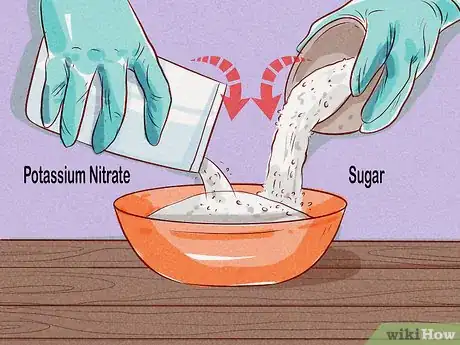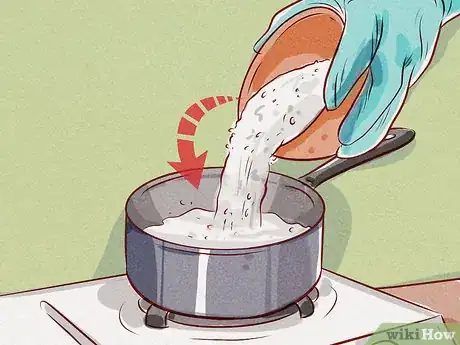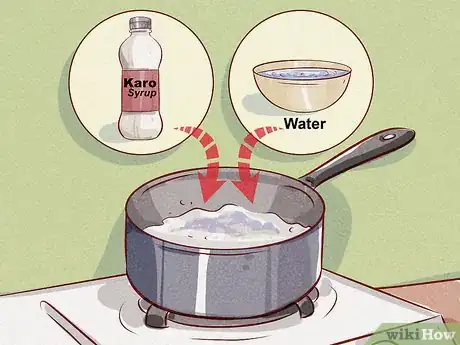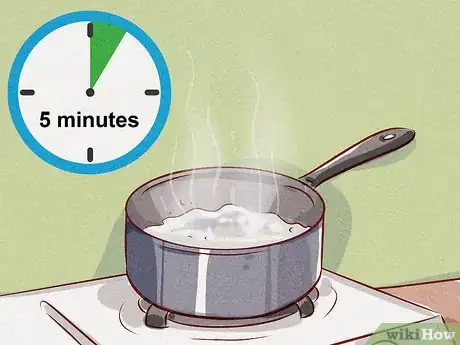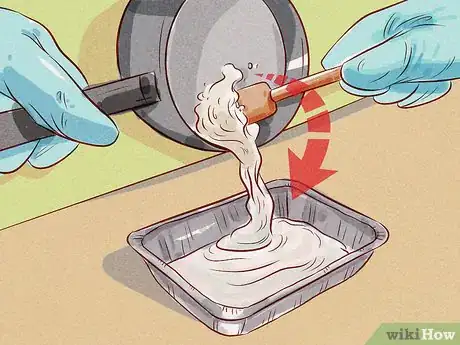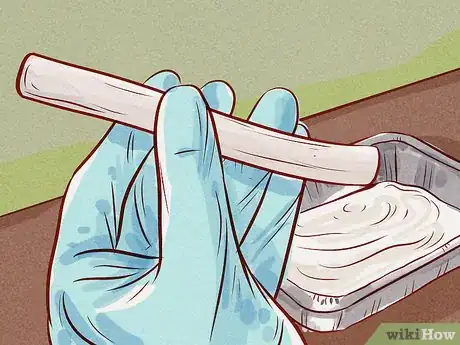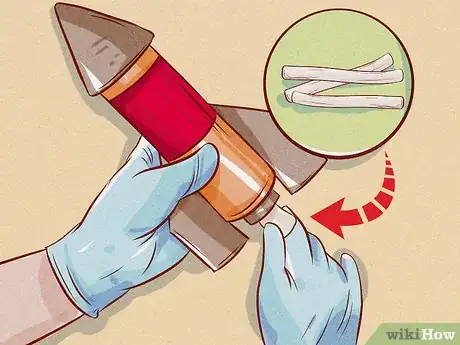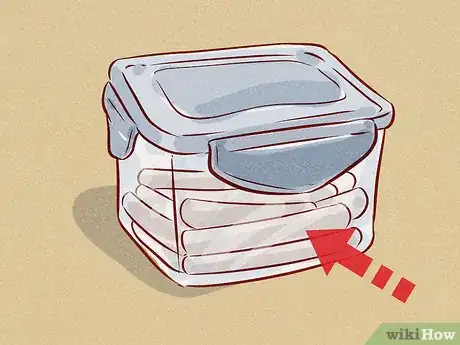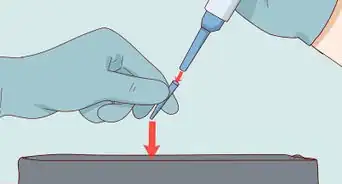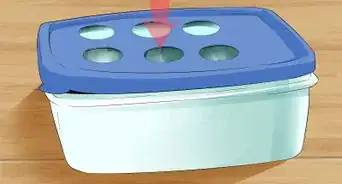This article was co-authored by wikiHow Staff. Our trained team of editors and researchers validate articles for accuracy and comprehensiveness. wikiHow's Content Management Team carefully monitors the work from our editorial staff to ensure that each article is backed by trusted research and meets our high quality standards.
There are 12 references cited in this article, which can be found at the bottom of the page.
wikiHow marks an article as reader-approved once it receives enough positive feedback. In this case, 89% of readers who voted found the article helpful, earning it our reader-approved status.
This article has been viewed 239,152 times.
Learn more...
Much like actual rockets, the miniature versions launched by model rocketry enthusiasts require fuel to blast off. Premade fuel cartridges are readily available at most hobby stores, but you might be surprised to learn that you can also can make your own rocket fuel at home using a few basic ingredients. All you have to do is heat powdered potassium nitrate, granulated white sugar, Karo syrup, and distilled water in a saucepan and mold the mixture to the desired size and shape once it cools off.
Ingredients
- 58 grams (2.0 oz) potassium nitrate (aka KNO3/saltpeter)
- 29 grams (1.0 oz) granulated white sugar
- 13 millilitres (0.055 c) Karo syrup
- 30 millilitres (0.13 c) distilled water
Steps
Mixing and Heating the Ingredients
-
1Grab a pair of gloves and some protective eyewear. Making your own rocket fuel is a fun DIY science project you can do at home. However, you’ll be working with potentially volatile chemicals, so it’s important to take some basic safety precautions. These items will keep you from coming into direct contact with hazardous substances.[1]
- Elbow-length pair of laboratory or dishwashing gloves is preferable, but a pair of disposable latex gloves will also work just fine.
- Clear goggles, like the kind worn in chemistry labs, are ideal, as they provide full coverage without hindering your vision.
-
2Mix the potassium nitrate and sugar together in a separate container. Add 58 grams (2.0 oz) of potassium nitrate and 29 grams (1.0 oz) of sugar to the container, then shake it vigorously until they’re evenly distributed. In order for your rocket fuel to burn properly, it’s important that your dry ingredients be well-sifted.[2]
- Use a kitchen scale to portion out your ingredients to make sure you have exactly the right amount of each.
- It’s recommended that you do your mixing in a disposable drinking cup. That way, you can simply throw it away once you’ve completed your experiment. If you use a measuring cup or similar container instead, be sure to wash it thoroughly before reusing it.
Advertisement -
3Transfer the potassium nitrate and sugar to a saucepan. This is where you'll actually be cooking the various ingredients down into usable fuel. When combined, they'll produce a malleable sugar-based substance that will burn intensely for a short period of time.[3]
- Sugar-based model rocket fuels are sometimes known as "R-Candy." They work by feeding a steady supply of oxygen to the burning sugar via an oxidizer (in this case, potassium nitrate) to create a powerful, sustained form of combustion.
-
4Add the Karo syrup and water to the saucepan. After shaking the blended potassium nitrate and sugar into the saucepan, drizzle in 13 millilitres (0.055 c) of Karo syrup. Pour in 80 millilitres (0.34 c) of water last, then stir all of the ingredients together thoroughly. The added moisture will help dissolve the sugar, which will act as a binder for the solid fuel.[4]
- You may need to use a spatula or similar utensil to scrape the last of the Karo syrup out of its measuring container.
-
5Heat the ingredients on an electric cooktop for 5 minutes. Turn on the stove or burner to medium heat and bring the mixture to a simmer. As it warms up, it will gradually begin to thicken into a gritty paste. [5]
- If possible, set up a portable burner outside far away from any other flammable substances.
- Never heat rocket fuel on a gas cooktop or over an open flame! Combustible chemicals plus fire can make for a disastrous combination.[6]
-
6Stir the fuel mixture constantly as it thickens. This will prevent it from sticking to the saucepan. You’ll know it’s ready when it takes on a color and consistency similar to peanut butter or wet sand. Once the reaches this stage, it may help to fold it over on itself rather than attempting to stir it like normal.[7]
- Be careful not to stir the mixture too fast, or you could accidentally send it sloshing out of the saucepan.
- Your rocket fuel may also come out a slightly lighter hue, depending on whether or not the heat causes the sugar to caramelize.[8]
Shaping and Storing the Rocket Fuel
-
1Transfer the solidified rocket fuel to a clean, flat surface. Use a spatula or wooden spoon to scrape the mixture out of the saucepan and onto a nonstick baking sheet, disposable pie pan, or similar surface. From here, you’ll use either your hands or an appropriately-shaped container to mold the rocket fuel into a usable form.[9]
- The mixture will be extremely hot when it first comes off of the burner, so avoid touching it until it’s had a chance to cool to a safe temperature.
- Make sure your new surface is completely free of debris. Any other particles your rocket fuel picks up may interfere with its ability to burn.
-
2Shape the rocket fuel to the desired shape with gloved hands. While the mixture is still slightly warm, pull it apart and squeeze, pat, or roll it into multiple pieces. You might make small balls, flattened cakes, or “snakes,” depending on the exact size and design of your model rockets. Be sure to leave your gloves on while handling the fuel.[10]
- If you allow the rocket fuel to cool too much, it may begin to crumble or fail to hold its shape.
- Be sure to gather up any small pieces that happen to come loose and knead them back into the bulk of the mixture. These pieces will be highly flammable.
-
3Add the mixture directly into one of your rockets to ensure that it will fit. Another option you have is to press the warm fuel directly to the back of one of your model rockets. You should only do this if you plan on launching the rocket right away, however, as the fuel will grow less combustible the longer it stays exposed to the air.[11]
- Loading up your fuel as soon as its finished cooking can also be a convenient solution if it’s gotten too crumbly to shape by hand.
- Once you’ve loaded, pack it down firmly using the end of a wooden dowel or a similar tool. Trapped air bubbles in the fuel could cause the rocket to explode when lit.[12]
-
4Store your molded rocket fuel in an airtight plastic container. If possible, choose a container with a locking lid, as one of these will provide the safest storage conditions. Double-check that the container is completely sealed before putting it away.
- If you don’t have a suitable container handy, place the molded fuel to a large plastic zipper bag. Make sure you squeeze all the air out of the bag prior to sealing it.
- Never put your rocket fuel in a glass container. If an accidental ignition were to occur, it could send shards of glass flying in every direction.[13]
- As long as it's kept away from air and moisture, your homemade fuel should stay combustible more or less indefinitely.
-
5Keep your rocket fuel stored at room temperature or cooler. Stash the sealed fuel container on a shelf or countertop away from any external heat sources. This is a critical safety precaution, as lower temperatures will help prevent the fuel from igniting accidentally.[14]
- You could also store your rocket fuel in the refrigerator to make absolutely sure that it doesn't catch. Just be sure to label your container if you go this route so you won't mistake its contents for food.
Community Q&A
-
QuestionHow high can a homemade rocket go?
 wikiHow Staff EditorThis answer was written by one of our trained team of researchers who validated it for accuracy and comprehensiveness.
wikiHow Staff EditorThis answer was written by one of our trained team of researchers who validated it for accuracy and comprehensiveness.
Staff Answer wikiHow Staff EditorStaff AnswerSome model rockets can reach altitudes of over 5 miles. A larger amateur rocket called the GoFast Rocket recently broke records by going as high as 72 miles!
wikiHow Staff EditorStaff AnswerSome model rockets can reach altitudes of over 5 miles. A larger amateur rocket called the GoFast Rocket recently broke records by going as high as 72 miles! -
QuestionWhat is the main ingredient of rocket fuel?
 wikiHow Staff EditorThis answer was written by one of our trained team of researchers who validated it for accuracy and comprehensiveness.
wikiHow Staff EditorThis answer was written by one of our trained team of researchers who validated it for accuracy and comprehensiveness.
Staff Answer wikiHow Staff EditorStaff AnswerIt depends on the type of rocket. Model rocket engines need 2 main ingredients: a fuel and an oxidizer. Your average model rocket uses some form of sugar (such as sucrose) as the fuel, and potassium nitrate as the oxidizer (or propellant).
wikiHow Staff EditorStaff AnswerIt depends on the type of rocket. Model rocket engines need 2 main ingredients: a fuel and an oxidizer. Your average model rocket uses some form of sugar (such as sucrose) as the fuel, and potassium nitrate as the oxidizer (or propellant). -
QuestionIs making rocket fuel illegal?
 wikiHow Staff EditorThis answer was written by one of our trained team of researchers who validated it for accuracy and comprehensiveness.
wikiHow Staff EditorThis answer was written by one of our trained team of researchers who validated it for accuracy and comprehensiveness.
Staff Answer wikiHow Staff EditorStaff AnswerThe laws may vary depending on where you live. In the U.S., it’s legal to make rocket fuel for model rockets. However, in some states, you may need a special permit to buy or use certain ingredients, or to build certain types of engines.
wikiHow Staff EditorStaff AnswerThe laws may vary depending on where you live. In the U.S., it’s legal to make rocket fuel for model rockets. However, in some states, you may need a special permit to buy or use certain ingredients, or to build certain types of engines.
Warnings
- Be extremely cautious when mixing, heating, and molding your rocket fuel. While accidental ignitions are relatively rare, they are possible.⧼thumbs_response⧽
- Prolonged exposure to air or humidity will render your rocket fuel unusable.⧼thumbs_response⧽
- Inspect your work area closely for any scraps of leftover fuel mixture when you’re done. These can be disposed of by dowsing them with a garden hose or rinsing them down the drain.⧼thumbs_response⧽
- Don’t ingest the rocket fuel mixture. Potassium nitrate isn’t technically toxic, but eating too much could make you sick.⧼thumbs_response⧽
Things You'll Need
- Gloves
- Eye protection
- Kitchen scale
- Small saucepan
- Spatula or wooden spoon
- Measuring cup
- Airtight storage container
References
- ↑ https://www.urmc.rochester.edu/encyclopedia/content.aspx?contenttypeid=1&contentid=1674
- ↑ https://www.nakka-rocketry.net/sucrose.html
- ↑ https://hackaday.com/2014/10/23/i-love-the-smell-of-rocket-candy-in-the-morning/
- ↑ https://jacobsrocketry.com/aer/caramel_candy_propellant.htm
- ↑ https://sciencing.com/rocket-fuel-out-of-sugar-4929615.html
- ↑ https://makezine.com/projects/make-35/homemade-sugar-rocket/
- ↑ https://makezine.com/projects/make-35/homemade-sugar-rocket/
- ↑ https://www.youtube.com/watch?v=yUYxk-y-tU8&feature=youtu.be&t=188
- ↑ https://www.youtube.com/watch?v=yUYxk-y-tU8&feature=youtu.be&t=113
- ↑ https://sciencing.com/rocket-fuel-out-of-sugar-4929615.html
- ↑ https://www.youtube.com/watch?v=jzV6Nrwakag&feature=youtu.be&t=129
- ↑ https://www.youtube.com/watch?v=5NgE6z3rfFY&feature=youtu.be&t=197
- ↑ https://nasdonline.org/917/d000760/storing-gasoline-and-other-flammables.html
- ↑ https://apps.dtic.mil/sti/citations/AD0755383
About This Article
To make rocket fuel, start by mixing potassium nitrate and sugar in a container. Then, transfer the mixture to a saucepan and add some Karo syrup and water. Next, heat the ingredients over medium heat for 5 minutes, stirring it constantly as it thickens. After 5 minutes, pour the mixture onto a baking sheet and mold it into your desired shape using gloved hands. Finally, attach your homemade fuel to your model rocket. To learn how to store leftover rocket fuel, scroll down!

